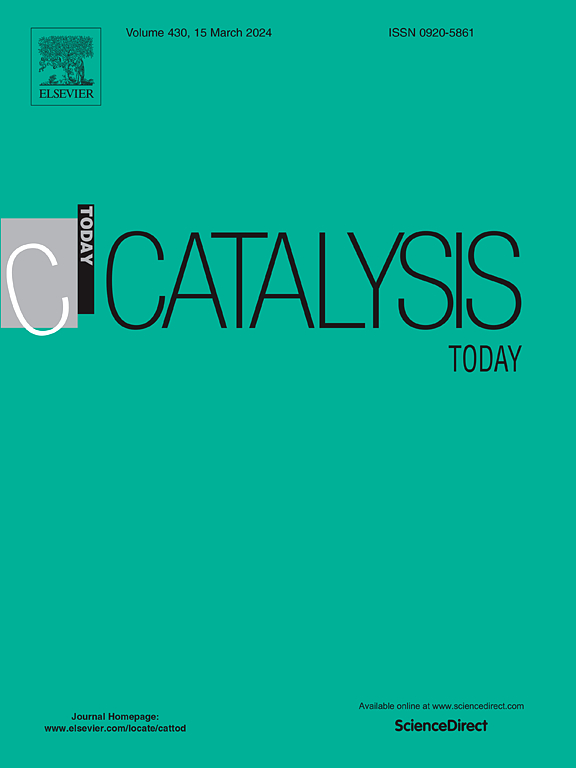用多向固定床反应器催化CO2甲烷化处理沼气
IF 5.2
2区 化学
Q1 CHEMISTRY, APPLIED
引用次数: 0
摘要
本研究的实验目的是确定在多向固定床反应器的多个进料口分布投料的效果。采用Ni-Mn催化剂对Sabatier反应(即二氧化碳甲烷化)进行沼气升级工艺,分析了添加二氧化碳或氢气对Sabatier反应(即二氧化碳甲烷化)的影响。这项工作分析了三种进料配置(传统固定床,沼气侧分布和氢气侧分布)和温度(350、375和400°C)对气体每小时空间速度(GHSV)范围从30 × 103 (STP) mL gcat−1 h−1到超过200 × 103 (STP) mL gcat−1 h−1的影响。反应物的摩尔比保持恒定(H2:CH4:CO2 = 12:7:3),模拟沼气中CH4和CO2的比例分别为70 v%和30 v%时CO2的加氢反应。实验结果表明,沼气侧分布比传统固定床反应器或氢气侧分布的效果更好。在375°C和400°C的温度下,这种进料配置比其他两种进料配置带来更高的转化率,同时在所有测试条件下始终显示出更高的甲烷选择性。因此,将该工艺的最优条件扩展到甲烷时空产率(STY),在此条件下甲烷产率最高。此外,确定了接触时间(GHSV)对甲烷的选择性和流量的影响至关重要。结果表明,在转化率一定的情况下,保持其他参数不变,较长的接触时间和较低的温度可以提高对甲烷的选择性。另一方面,它也影响sti值,其中在180 × 103 (STP) mL gcat−1 h−1时,所采用的反应物流量与反应性能之间达到最佳值,与实验条件无关。本文章由计算机程序翻译,如有差异,请以英文原文为准。
Catalytic CO2 methanation for biogas upgrading using a polytropic fixed bed reactor
The experiments of this study aim to determine the effect of distributed feeding of reactants throughout the many inlets of a polytropic fixed bed reactor. The effect of dosing either carbon dioxide or hydrogen, was analyzed on the Sabatier reaction (i.e., carbon dioxide methanation) using a Ni-Mn catalyst to carry out the biogas upgrading process. This work analyzes the influence of three feeding configurations (a conventional fixed bed, one with side distribution of biogas, and another with side distribution of hydrogen) and temperatures (350, 375, and 400 °C) for a wide gas hourly space velocity (GHSV) range from 30 × 103 (STP) mL gcat−1 h−1 to more than 200 × 103 (STP) mL gcat−1 h−1. The molar ratios of reactants were always kept constant (H2:CH4:CO2 = 12:7:3) simulating the hydrogenation of the CO2 present in a biogas with a proportion of 70 v% of CH4 and 30 v% of CO2.
The empirical results highlight that side distribution of biogas yields improved results over those obtained in a conventional fixed bed reactor, or the one with side distribution of hydrogen. At temperatures of 375 and 400 °C, this feeding configuration brings higher conversions than the other two, while consistently shows greater selectivities to methane for all the conditions tested. As such, its optimal condition to conduct the process is extended to methane space-time yields (STY), for which the highest methane productions are obtained. In addition, the influence of contact time, or GHSV, was determined to be critical both on selectivities and flowrates of methane. It is shown that for a given conversion value, keeping constant all the other parameters, a longer contact time and lower temperature result in an improvement of selectivities to methane. On the other hand, it also affects STY values, where an optimum between the employed flows of reactants and reaction performances is reached at a value of 180 × 103 (STP) mL gcat−1 h−1, independently of experimental conditions.
求助全文
通过发布文献求助,成功后即可免费获取论文全文。
去求助
来源期刊

Catalysis Today
化学-工程:化工
CiteScore
11.50
自引率
3.80%
发文量
573
审稿时长
2.9 months
期刊介绍:
Catalysis Today focuses on the rapid publication of original invited papers devoted to currently important topics in catalysis and related subjects. The journal only publishes special issues (Proposing a Catalysis Today Special Issue), each of which is supervised by Guest Editors who recruit individual papers and oversee the peer review process. Catalysis Today offers researchers in the field of catalysis in-depth overviews of topical issues.
Both fundamental and applied aspects of catalysis are covered. Subjects such as catalysis of immobilized organometallic and biocatalytic systems are welcome. Subjects related to catalysis such as experimental techniques, adsorption, process technology, synthesis, in situ characterization, computational, theoretical modeling, imaging and others are included if there is a clear relationship to catalysis.
 求助内容:
求助内容: 应助结果提醒方式:
应助结果提醒方式:


